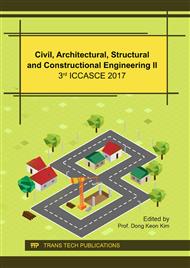[1]
Chilean Agency of Energy Efficiency, Manual for Energy Management - Construction, (2014).
Google Scholar
[2]
M. Carpio, M. Zamorano, and M. Costa, Impact of using biomass boilers on the energy rating and CO2 emissions of Iberian Peninsula residential buildings, Energy Build., 66(0) (2013) 732–744.
DOI: 10.1016/j.enbuild.2013.07.079
Google Scholar
[3]
M. Owrak, M. Aminy, M. T. Jamal-Abad, and M. Dehghan, Experiments and simulations on the thermal performance of a sunspace attached to a room including heat-storing porous bed and water tanks, Build. Environ. 92 (2015) 142–151.
DOI: 10.1016/j.buildenv.2015.04.022
Google Scholar
[4]
D. Ignjatović, M. Jovanović Popović, and J. Kavran, Application of sunspaces in fostering energy efficiency and economical viability of residential buildings in Serbia, Energy Build., 98 (2015) 3–9.
DOI: 10.1016/j.enbuild.2015.02.049
Google Scholar
[5]
F. Asdrubali, F. Cotana, and A. Messineo, On the evaluation of solar greenhouse efficiency in building simulation during the heating period, Energies, 5(6) (2012) 1864–1880.
DOI: 10.3390/en5061864
Google Scholar
[6]
G. Mihalakakou, On the use of sunspace for space heating/cooling in Europe, Renew. Energy, 26(3) (2002) 415–429.
DOI: 10.1016/s0960-1481(01)00138-0
Google Scholar
[7]
A. R. Rempel, A. W. Rempel, K. V. Cashman, K. N. Gates, C. J. Page, and B. Shaw, Interpretation of passive solar field data with EnergyPlus models: Un-conventional wisdom from four sunspaces in Eugene, Oregon, Build. Environ., 60 (2013) 158–172.
DOI: 10.1016/j.buildenv.2012.11.006
Google Scholar
[8]
A. Sánchez-Ostiz, A. Monge-Barrio, S. Domingo-Irigoyen, and P. González-Martínez, Design and experimental study of an industrialized sunspace with solar heat storage, Energy Build., 80 (2014) 231–246.
DOI: 10.1016/j.enbuild.2014.05.031
Google Scholar
[9]
M. Carpio, A. García-Maraver, D. P. Ruiz, and M. Martín-Morales, Impact of the envelope design of residential buildings on their acclimation energy demand, CO2 emissions and energy rating, WIT Trans. Ecol. Envir., 186 (2014) 387–398.
DOI: 10.2495/esus140331
Google Scholar
[10]
M. Krem, S. T. Hoque, S. R. Arwade, S. F. Breña, and M. Asce, Structural Configuration and Building Energy Performance, J. Archit. Eng., 19 (2013) 29–41.
DOI: 10.1061/(asce)ae.1943-5568.0000103
Google Scholar
[11]
S. Kota, J. S. Haberl, M. J. Clayton, and W. Yan, Building Information Modeling (BIM)-based daylighting simulation and analysis, Energ. Build. 81 (2014) 391–403.
DOI: 10.1016/j.enbuild.2014.06.043
Google Scholar
[12]
A. O. Asojo, An instructional design for Building Information Modeling (BIM) and Revit in interior design curriculum, Art, Des. Commun. High. Educ., 11(2) (2012) 143–154.
DOI: 10.1386/adch.11.2.143_1
Google Scholar
[13]
Government of Chile, General Ordinance of Urbanism and Construction, Ministry of Housing and Urbanism. (2016).
Google Scholar
[14]
Government of Chile , ED11 Official List of Construction Solutions, 1434, (2014).
Google Scholar
[15]
M. Carpio, M. Martín-Morales, and M. Zamorano, Comparative study by an expert panel of documents recognized for energy efficiency certification of buildings in Spain, Energy Build., 99 (2015) 98–103.
DOI: 10.1016/j.enbuild.2015.04.022
Google Scholar
[16]
S. Muñoz, Anwandter's Home: Historical Tour and Analysis for Aesthetic Recovery, Rev. Austral Ciencias Soc., 9 (2005) 25–37.
Google Scholar
[17]
M. Carpio, J. Jódar, M. L. Rodíguez, and M. Zamorano, A proposed method based on approximation and interpolation for determining climatic zones and its effect on energy demand and CO2 emissions from buildings, Energy Build., 87 (2015) 253–264.
DOI: 10.1016/j.enbuild.2014.11.041
Google Scholar
[18]
J. C. Inzunza, Köppen climate classification, Cienc. Ahora, 33, (2005).
Google Scholar
[19]
Municipality of Valdivia, Climate and Vegetation - Official website www. munivaldivia. cl (Access in March 2017).
Google Scholar


